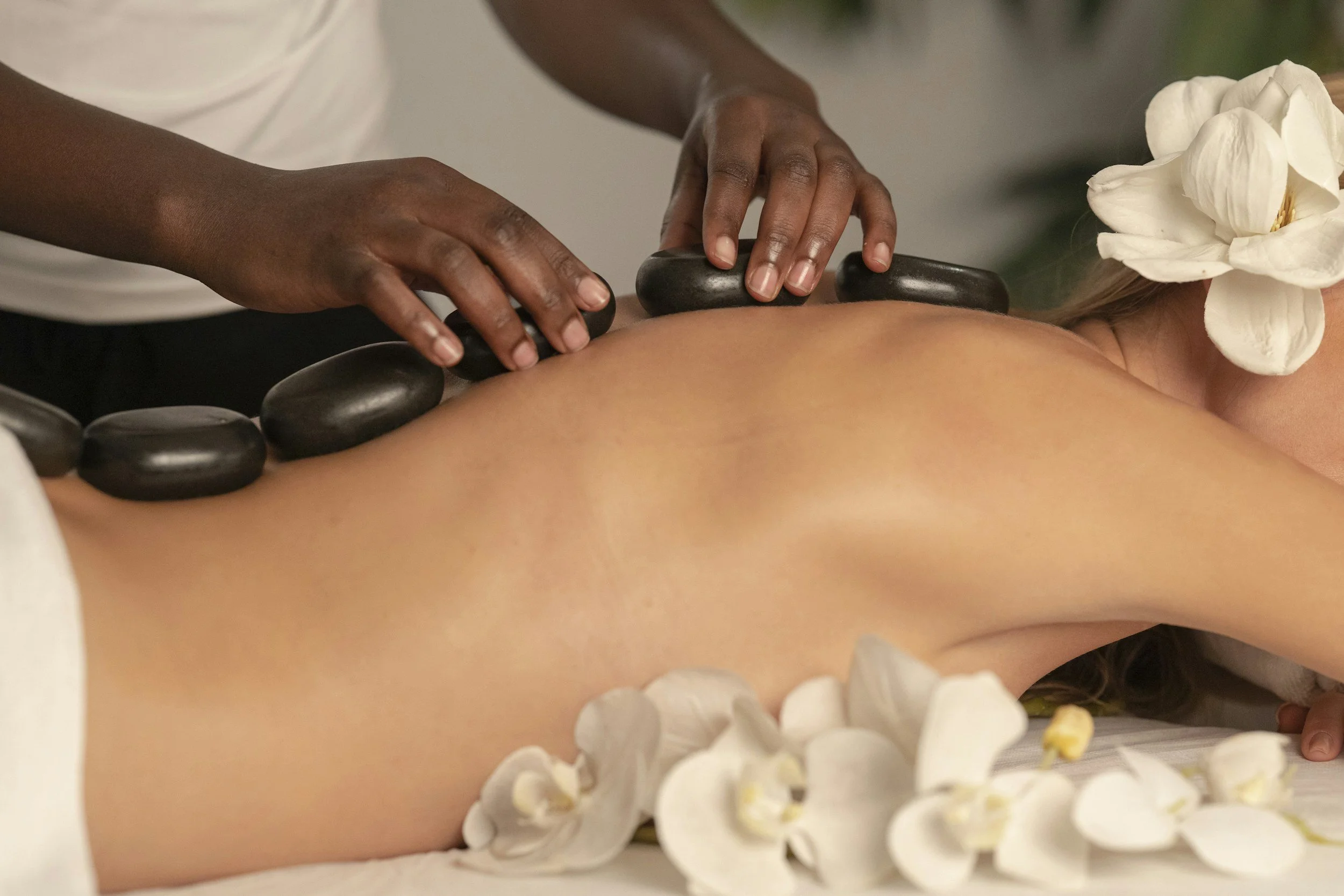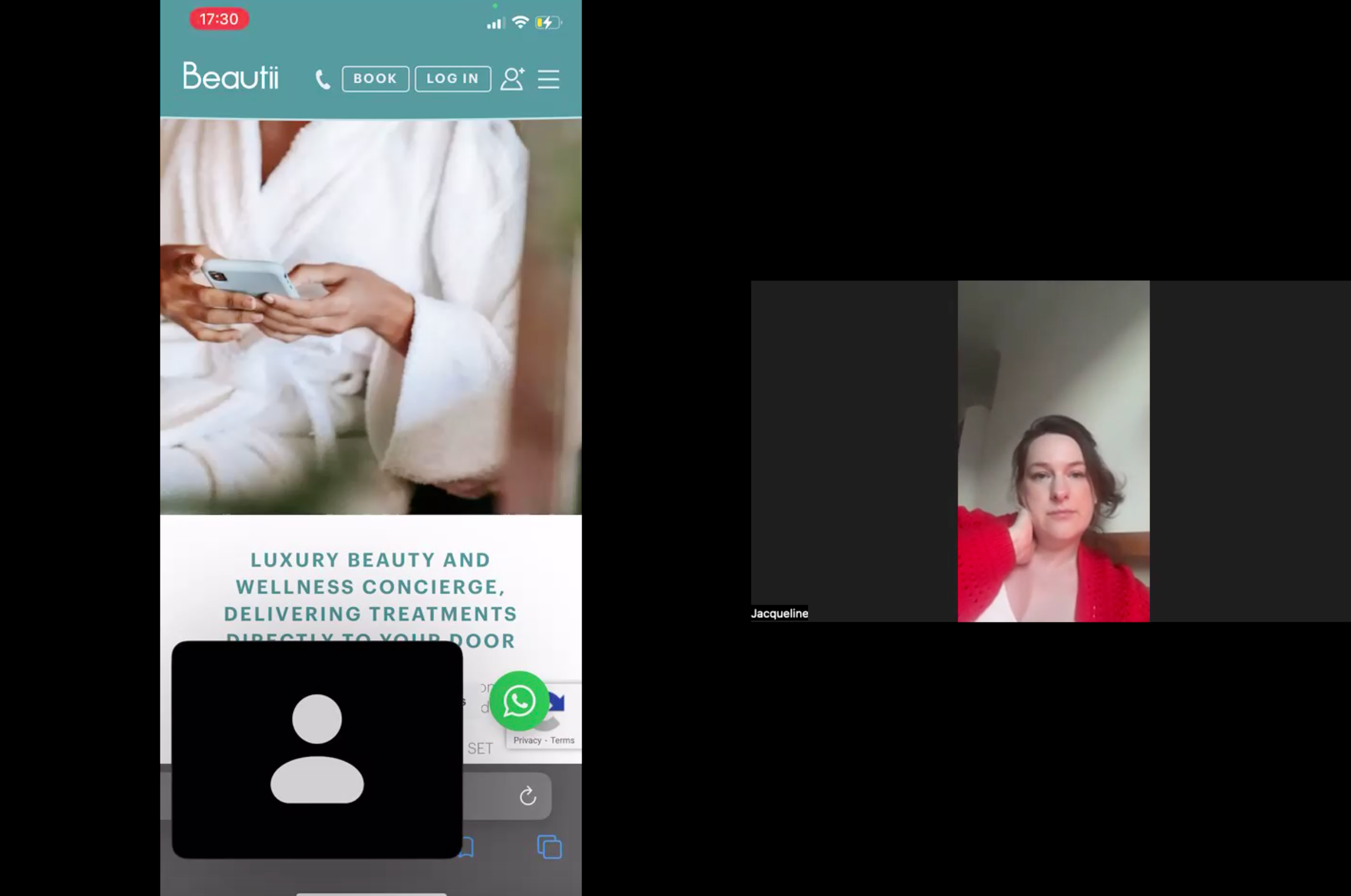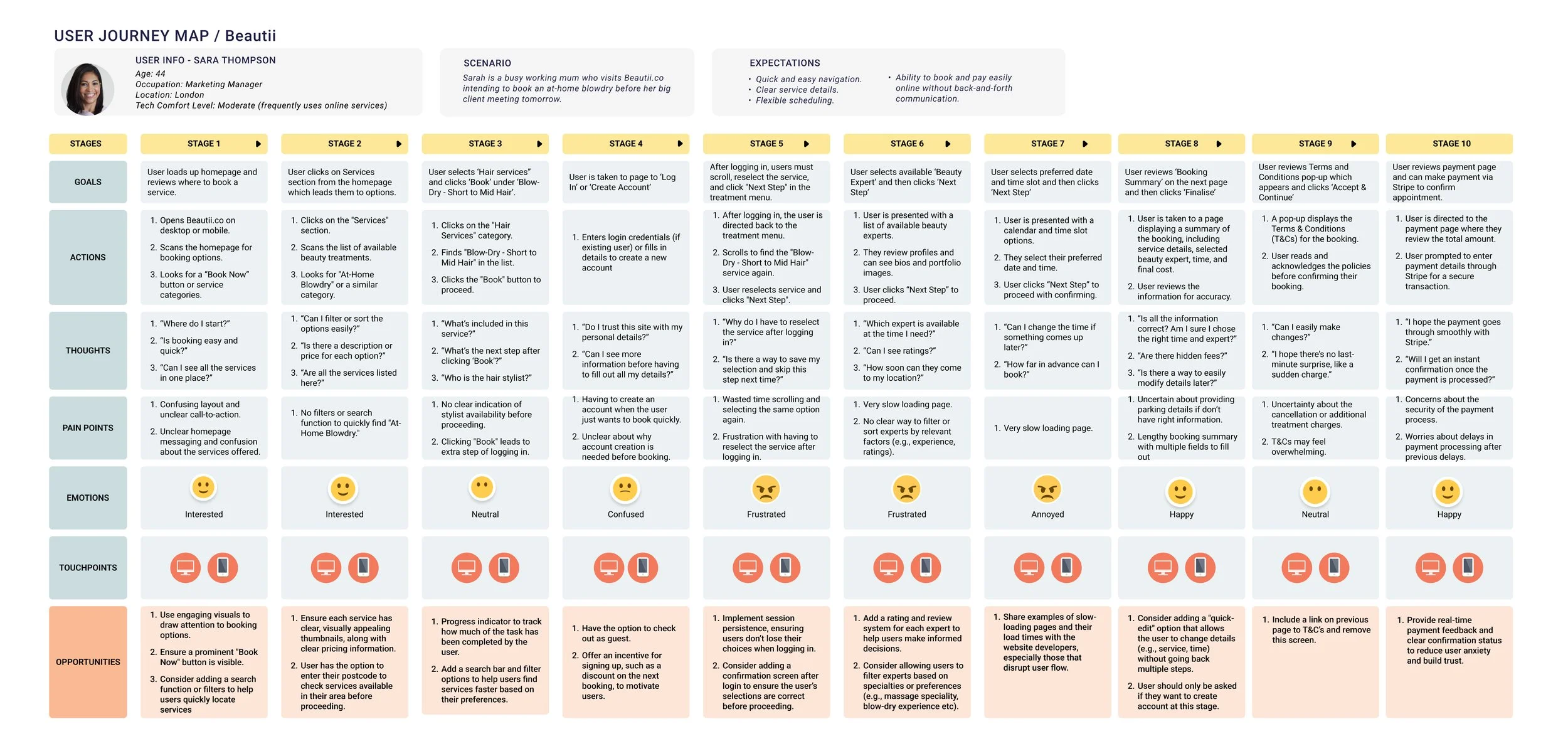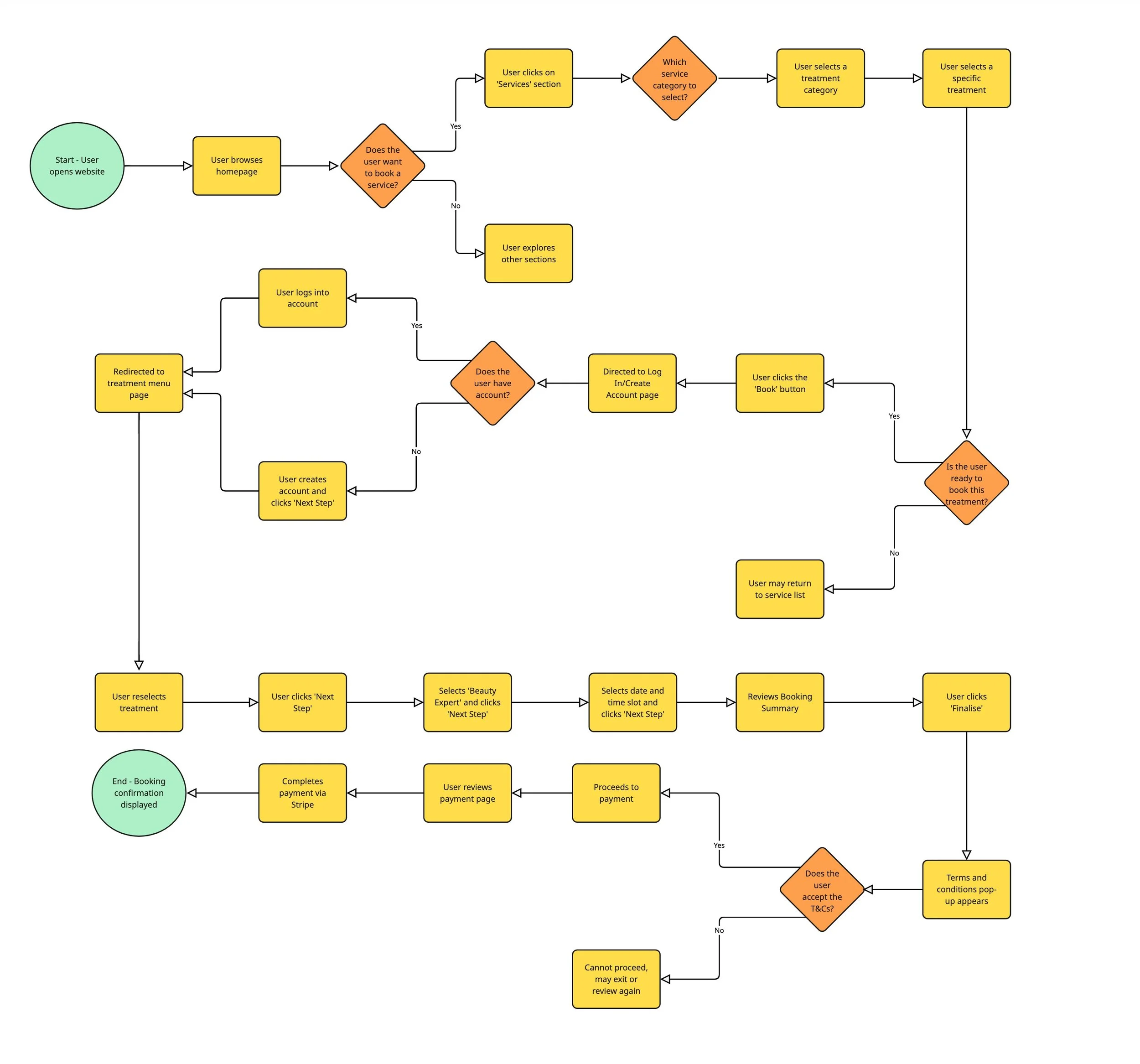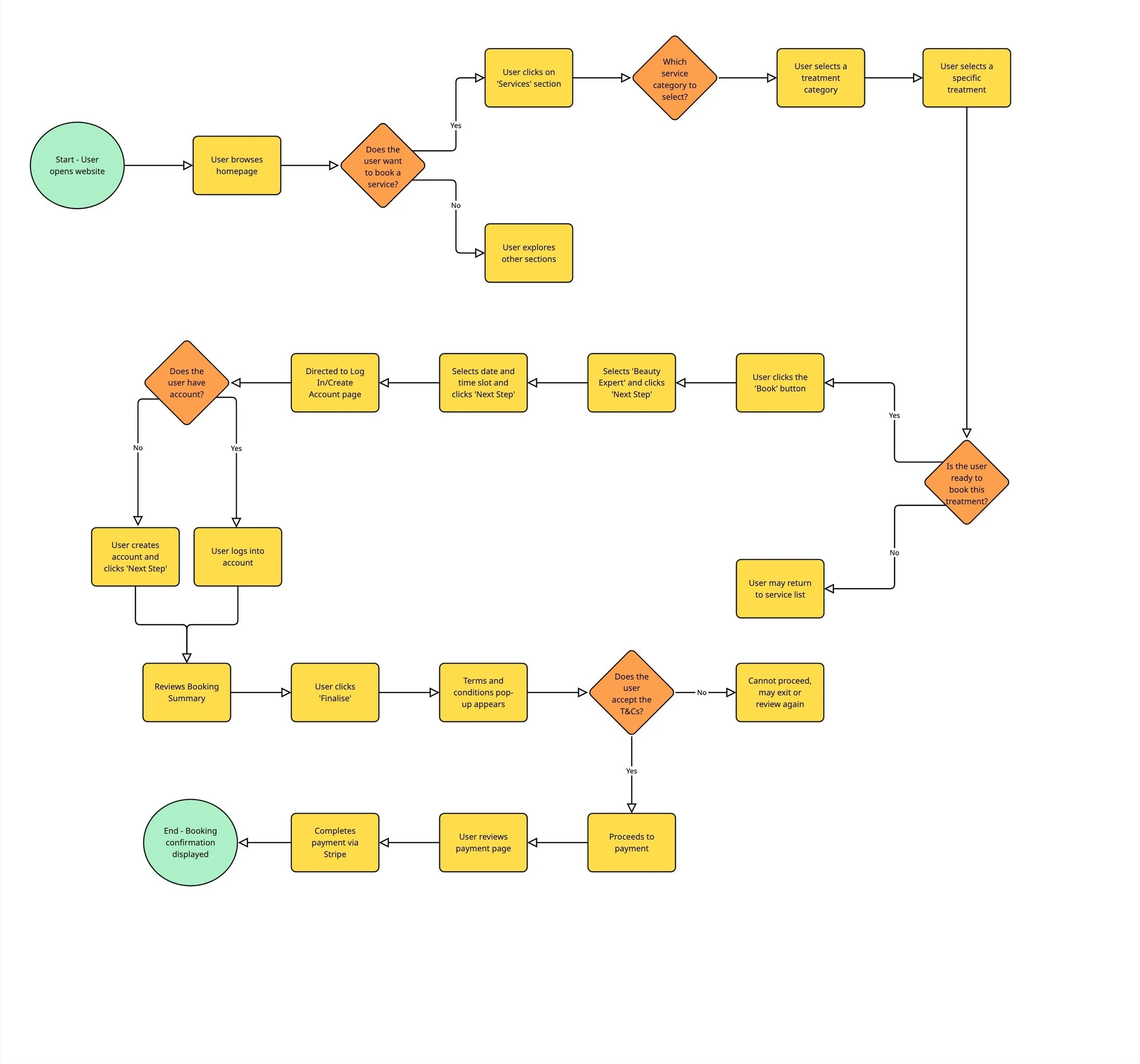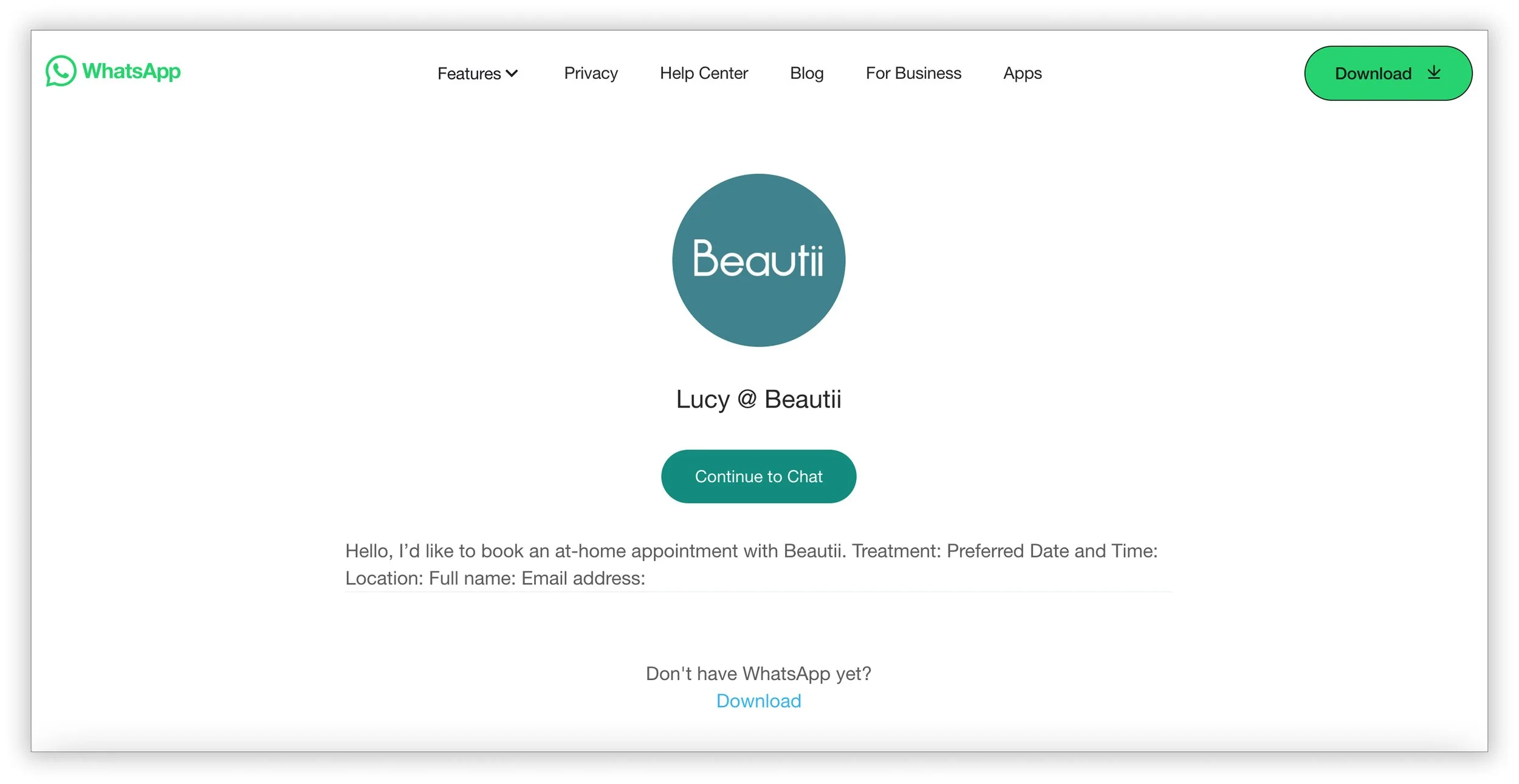Beautii.co
Beautii.co
Role: Lead UX Designer
Tools: Figma, Miro, Typeform, Magic Patterns & Zoom
Timeline: 8 months (January - August 2025)
Beautii.co is London’s leading concierge service, offering luxury at-home beauty treatments. They work with top celebrity make-up artists, hairdressers and beauty experts to provide services such as massages, facials, spray tans and more, at your home, office or hotel.
Business Goals & Objectives
My brief was to identify usability issues and redesign the booking flow to make it faster, clearer, and more engaging for their target audience: women aged 30–70.
We wanted to improve several specific metrics - increase conversion rate of consumers paying for services on Beautii’s website, enhance customer satisfaction and simplify and streamline the booking process.
The Problem
Despite high interest in their services, Beautii’s booking conversion rates were below expectations. Testing and research revealed users were facing friction points that made it harder to complete a booking. Early login prompts, limited visibility of services prior to account registration, lengthy appointment request forms, unclear error messaging and missing trust signals (e.g. reviews, limited information on beauticians) were all causing drop-offs.
Goals:
Increase completed bookings.
Improve browsing experience before sign-up.
Build trust through transparent information (reviews, provider profiles).
Reduce booking friction.
Competitor Research
To better understand Beautii’s position within the at-home beauty and wellness market, I conducted a competitive analysis of three of their biggest competitors — Urban, Secret Spa, and Ruuby. The goal was to identify the key differences in their user experience, service transparency and trust-building strategies. By comparing these platforms against Beautii, I aimed to uncover opportunities to enhance Beautii’s digital experience, particularly around how users discover services, evaluate therapists and book treatments with confidence.
Key Findings:
Competitors allow browsing before sign-up.
Location checking happens early in flow.
Reviews and provider profiles are prominent.
Beautii’s current booking process relies heavily on manual coordination. Customers typically need to submit an enquiry form, send an email, or call to confirm an appointment.
Competitors such as Urban, Secret Spa, and Ruuby all offered several features that Beautii currently lacked, including:
Service Visibility Before Signup
Competitors allow users to browse full treatment lists, see pricing, therapist bios, and reviews without creating an account.
Therapist Profiles & Trust Signals
Therapist bios with their qualifications and experience, and customer ratings are visible before booking — helping users build confidence and trust.
Key Insights:
Competitors reinforce trust with visible therapist bios, reviews, and clear pricing — areas Beautii can improve.
Beautii’s personal approach needed to be preserved while introducing modern UX elements such as instant booking.
Competitors such as Urban, Secret Spa, and Ruuby all offered several features that Beautii currently lacked, including:
Instant Self-Service Booking
Users can view real-time availability, receive instant confirmations, and book same-day appointments directly within the platform.
Geographic Coverage Transparency
Competitors provide clear service area maps or postcode checks early in the journey, setting accurate user expectations.
Survey
A survey of 35 women aged 30–60 was conducted to evaluate the usability of Beautii.co using quantitative and qualitative questions.. 56% of participants said they booked beauty services online at least once a month and were asked to explore the site, assessing:
Ease of finding treatments.
Clarity of treatment descriptions and pricing.
Any points of confusion or frustration.
Suggested improvements.
Overall design and navigation.
User Impact Statistics
Percentage of users affected by each issue
👤 Trust – 98% wanted to see who would be performing the treatments.
🧭 Navigation – 94% reported challenges with website navigation.
📅 Accessibility – 94% expected to be able to book a treatment without having to get in touch.
⭐ Reviews – 80% wanted more visible customer reviews.
💰 Pricing – 75% found pricing unclear or hard to locate.
📄 Treatment Info – 62% felt the treatment descriptions lacked enough detail.
Usability Testing
Participant 1
Jade, 35, Copywriter
“I think it seems unnecessary to request personal details before allowing me to browse the site and view pricing.”
Participant 3
Jacqueline, 42, Consultant
“What does beauty and wellness concierge mean? They are providing treatments in your own home as far as I understand it but that literally sounds like they are just turning up and delivering something.”
To validate Beautii’s current booking flow and uncover real pain points, I conducted usability testing with three women from different age groups and backgrounds within Beautii’s target demographic who all book beauty services regularly, two using desktop devices and one via mobile. Each participant was asked to imagine they were booking an at-home treatment through Beautii, for example a massage, while also exploring what other services the site offered.
The task was designed to replicate a realistic first-time booking experience: navigating from the homepage, browsing services, selecting a treatment, and moving through the booking steps up to just before confirming the appointment.
By observing how participants interacted with the site, I was able to capture their first impressions, moments of friction, and overall satisfaction. This process provided detailed insights into how real customers interpret Beautii’s interface.
Participant 2
Hannah, 40, Designer
“I don’t understand if theres an error, why the system doesn’t say what caused it and there’s no way to get back and resolve it.”
Main Issues Observed:
Frustration at having to log in before browsing.
Confusion from vague error messages: (e.g., simply stating "error" without explanation) Participants found it misleading that some services seemed bookable but then resulted in an error message later in the process.
Uncertainty about service availability in their area. Lack of a location checker in the process frustrated users, as they wasted time attempting to book unavailable services.
All participants found the booking process involved too many steps and multiple redirects, leading to confusion and frustration.
Participants expected to see reviews under individual services but could only find them in a less obvious "Customer Love" section.
All participants found the homepage messaging and branding unclear.
Customer Journey Map
Visual representation of the booking process highlighted pain points such as the repeated login steps, confusing navigation and user expectations not being met. This ensured we had the necessary insights to create a seamless and effective journey for Beautii’s ideal customer. The user persona was developed from the target demographic information provided by Beautii and real world user data collected from my research.
User Flow
This diagram outlined all steps in the booking process to reveal friction points. Several areas where there was room for improvement in the website’s overall flow were identified.
The login process: customers are forced to login or create an account before browsing.
Enabling a location based search at the start of the process.
Preventing the need to reselect treatments from a second treatment menu after logging in or creating an account.
These changes would help users reach their end goal of booking a treatment more quickly and smoothly. The yellow boxes represent an 'Action' and the orange boxes are 'Decisions'.
I then created an updated user flowchart. It highlights how removing a few key obstacles can make the user journey faster and more effective. Specifically I removed the prompt for users to log in or create an account before browsing services and also ensuring users don't have to reselect a treatment after logging in or creating an account. Instead, users would only be asked to log in or create an account at the final step before completing their booking and without needing to reselect their treatment. The updated flow now provides a seamless booking experience, reducing friction for users.
Low - Mid Fidelity Wireframes
I created low-fidelity frames in Figma to explore structure, layout, and user flow without focusing on visuals yet. One key design decision would be a location checker at the very start of the booking flow, directly on the homepage.
During usability testing, many participants expressed frustration at discovering service availability only after completing multiple steps — creating an account with Beautii, searching for a treatment, selecting a treatment, and then learning it wasn’t offered in their area. This caused unnecessary friction, abandonment, and wasted time.
By moving the location step to the beginning, users can immediately see which treatments and therapists are available near them and simplify navigation, reduce drop-off rate and frustration.
In this wireframe, I also introduced a ‘Select Service’ dropdown beside the location field. This change allows users to view and choose treatments immediately, eliminating the need to sign up first or navigate multiple pages before exploring available services.
In the original Beautii booking flow, users were required to select a treatment, then log in or create an account, only to be redirected to a second treatment menu where they had to make the same selection again. This process added unnecessary friction and caused several users to drop off before completing a booking.
To address this I redesigned the service selection experience so users could view and choose treatments immediately after checking location availability — without needing to sign up first. By removing the account barrier and duplicate selection step, the new flow felt faster and more aligned with user expectations for an on-demand service. This would also eliminate the slow loading screens, which some users in usability tests said made them feel uncertain about the website’s safety and the security of their data.
Before After
During early exploration, I created another low-fidelity wireframe in Figma to address a key brand identity issue identified during research: users didn’t clearly understand what Beautii offered. Usability testing revealed that the tagline ‘Luxury beauty and wellness concierge’ felt vague and didn’t communicate that Beautii provided at-home beauty services. In addition, the existing homepage imagery and content suggested a focus on corporate events, leading some users to feel that home services were secondary.
To solve this, I designed a simplified ‘How It Works’ section to make Beautii’s value proposition immediately clear. The step-by-step explanation from choosing a location to booking an appointment grounded the brand in an approachable, service-oriented narrative. This reframing would help reposition Beautii as a trusted, at-home luxury experience, rather than an exclusive events service.
Before After
In the original booking flow, users had to select a therapist on one page and then move to a separate screen to choose the date and time, making the process feel unnecessarily long. During usability testing, this step-by-step progression was identified as a key pain point, as users preferred to make all their booking decisions in one place.
To streamline the experience, I redesigned the booking interface to include date, therapist, and time selection on a single page. This allowed users to easily compare therapist availability and ratings before finalising their choice. The addition of visible reviews and star ratings provides immediate reassurance and helps users make confident, informed decisions without leaving the page.
High-Fidelity Prototype
To explore high-fidelity interactions, I created a Figma prototype with simplified navigation and a streamlined booking flow. This prototype included all my key proposed improvements, such as a persistent shopping cart, an upfront postcode availability check, fewer steps and screens, a single unified menu, more detailed therapist information, and the option to browse without creating an account. This interactive prototype was tested internally to demonstrate the improved booking flow.
Collaboration & Implementation
Before
Before
Streamlining the Booking Flow
One of the first changes implemented was removing the contact request form that appeared when users couldn’t find an available appointment. Previously this form required users to re-enter all their details, the treatment type and preferred date and time. Even though they had already provided this earlier in the booking flow. This created unnecessary friction and frustration.
To improve the experience, we replaced the form with an instant WhatsApp chat feature, allowing users to connect directly with Beautii’s concierge team in real time. This change eliminated redundant data entry, reduced response wait times, and made the experience feel more personal and immediate — aligning with Beautii’s luxury, high-touch brand positioning.
After
Introducing Real-Time Booking and Availability
One of the core problems with Beautii business model was that the people at Beautii did not have access to the therapists availability so behind the scenes were having to call to check availability before confirming appointments with users. To avoid this problem I then worked with the web developers in India to introduce the platform: SimplyBook.me and integrate it into the current website to provide the foundation for real-time availability and automation:
Key Capabilities:
Two-way Google Calendar sync for all therapists.
Service area configuration for location-based matching.
Automated confirmations and receipt.
This then meant that as more therapists shared their calendars via SimplyBook.me with Beautii, that users were able to do more instant bookings without having to request a date/time.
Trust
To build credibility and address user concerns, a Trustpilot widget was added to the homepage. User feedback indicated that seeing genuine reviews would increase their confidence in booking a service.
Branding
Originally, the homepage highlighted three specific at-home services — Nails, Hair, and Spray Tans. However, this caused confusion around the full scope of Beautii’s offerings. To clarify the brand’s positioning and better communicate its range, we restructured this section to showcase Beautii’s three core service areas instead: At-Home Appointments, Hotel & Spa Services, and Agency & Events.
This update was added to the homepage to strengthen brand clarity, and improve user understanding
After
Error Handling
Error messages were vague (e.g. simply stating "error" without explanation). The new message improves the experience by clearly explaining that the lack of availability doesn’t reflect the full schedule, reassuring users that they can still book manually. It also provides clear next steps, offering options to contact Beautii, which helps users continue their booking journey with confidence rather than abandoning it. This more transparent and supportive tone transforms a moment of friction into an opportunity for trust and engagement.
Before
After
Results
Beautii was processing approximately 20 bookings daily through a manual system that resulted in 80% of bookings requiring manual processing due to users not being able to instant book and over 8 hours of administrative work. By streamlining more operations via Whatsapp, the transformation of Beautii’s booking system delivered a dramatic improvement in efficiency, customer experience, and financial performance. Within the first three months of making the outlined changes, the results exceeded expectations:
Booking volume increased by 70%, driven by real-time therapist availability and automated WhatsApp bookings.
Rebooking rates dropped from 80% to under 20%, eliminating one of the most critical operational bottlenecks.
Over 70% of all bookings were successfully automated through WhatsApp, freeing staff from constant manual scheduling.
Manual processing time was reduced by more than 75%, cutting administrative workload from 8+ hours daily to under 2 hours.
£2,400 in monthly manual processing costs were eliminated, delivering an immediate financial return.
Beyond the UX changes, Beautii’s booking system unlocked 24/7 booking capabilities, improved therapist utilisation across a pool of 150+ professionals, and significantly boosted customer satisfaction through faster responses and fewer booking errors.
This transformation not only streamlined daily operations but also positioned Beautii for scalable growth, allowing the business to expand geographically without increasing administrative overhead.
Future
My time working with Beautii highlighted how UX design and operational improvements go hand in hand. By addressing both the front-end experience and the back-end booking process, I helped create a solution that not only improves usability but also increases the efficiency of Beautii’s overall business model.
As a small company, Beautii faced both budget and technical limitations. The costs of integrating SimplyBook.me—along with onboarding therapists into the new real-time availability system required a significant investment. Because of this, the business could not afford to implement additional design or functionality changes to the website at this stage.
To guide future development, I delivered a detailed UX roadmap outlining phased improvements that can be introduced as resources allow:
Phase 1: Location Integration
Build the postcode-based location feature shown in my prototype so users only see services available in their area. This would reduce booking errors, set accurate expectations, and improve overall satisfaction.
Phase 2: Mobile App Development
As many users prefer to book via mobile, developing a dedicated Beautii app will be key to future growth. A mobile-first experience would improve accessibility, streamline bookings, and better align with user behaviour in the on-demand beauty market.
Phase 3: Chatbot
Since around 70% of bookings come through WhatsApp and Beautii promises to respond to all enquiries between 9 a.m. – 9 p.m., I proposed implementing a chatbot capable of managing the entire booking flow outside of office hours if a customer is not able to instant book and requires the Whatsapp service. This would prevent potential bookings from being lost overnight and provide customers with 24/7 support. I also created a Figma prototype demonstrating the automated conversation flow as an example of how this could work in practice.





